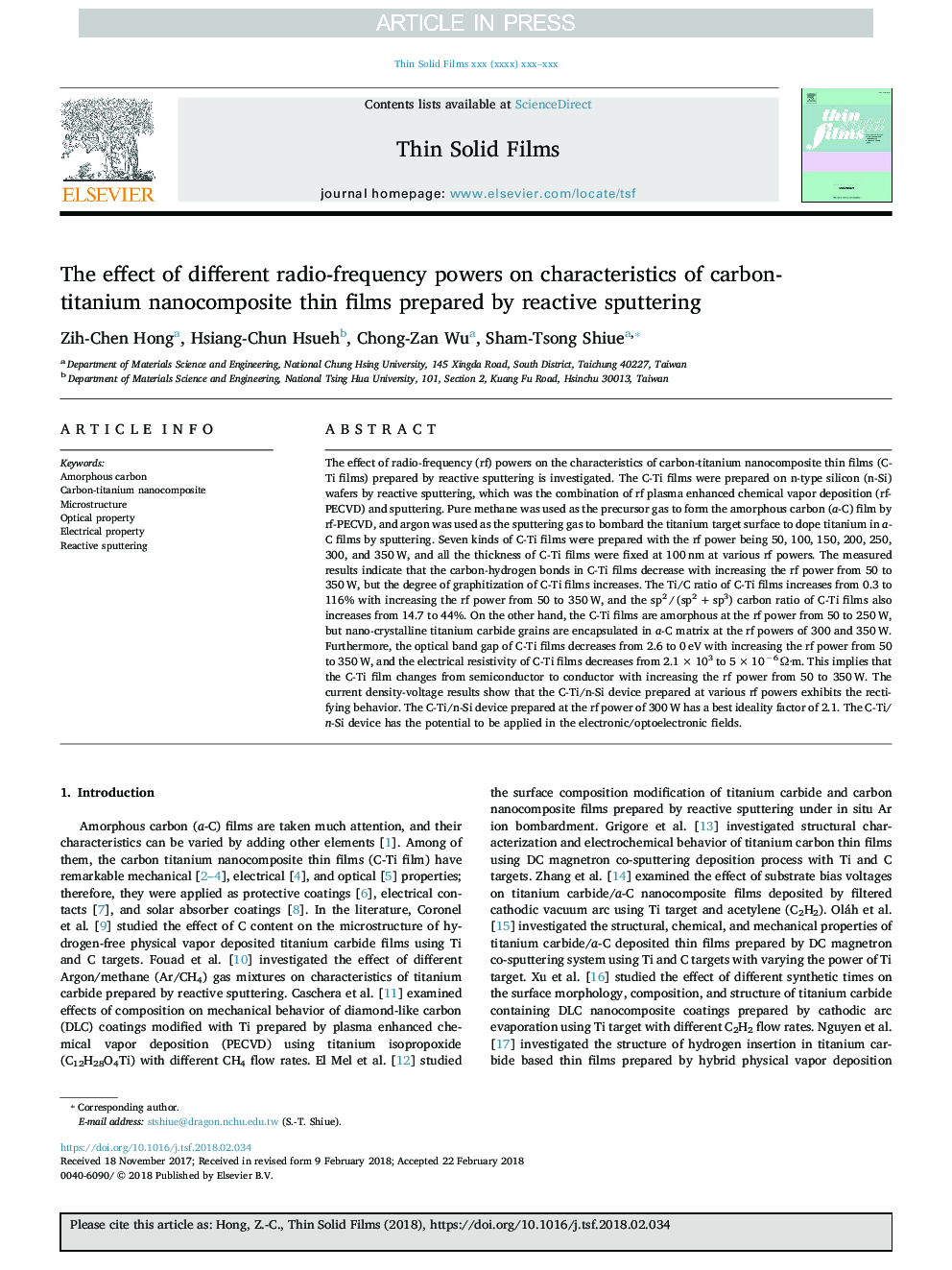| کد مقاله | کد نشریه | سال انتشار | مقاله انگلیسی | نسخه تمام متن |
|---|---|---|---|---|
| 8032550 | 1517952 | 2018 | 8 صفحه PDF | دانلود رایگان |
عنوان انگلیسی مقاله ISI
The effect of different radio-frequency powers on characteristics of carbon-titanium nanocomposite thin films prepared by reactive sputtering
ترجمه فارسی عنوان
اثر قدرت های مختلف فرکانس رادیویی بر ویژگی های نازک نانوکامپوزیت کربن تیتانیوم تهیه شده توسط اسپکترومایسنجی
دانلود مقاله + سفارش ترجمه
دانلود مقاله ISI انگلیسی
رایگان برای ایرانیان
کلمات کلیدی
کربن آمورف، نانوکامپوزیت کربن تیتانیوم، ریز ساختار، اموال نوری، اموال برق، اسپری واکنش پذیر،
موضوعات مرتبط
مهندسی و علوم پایه
مهندسی مواد
فناوری نانو (نانو تکنولوژی)
چکیده انگلیسی
The effect of radio-frequency (rf) powers on the characteristics of carbon-titanium nanocomposite thin films (C-Ti films) prepared by reactive sputtering is investigated. The C-Ti films were prepared on n-type silicon (n-Si) wafers by reactive sputtering, which was the combination of rf plasma enhanced chemical vapor deposition (rf-PECVD) and sputtering. Pure methane was used as the precursor gas to form the amorphous carbon (a-C) film by rf-PECVD, and argon was used as the sputtering gas to bombard the titanium target surface to dope titanium in a-C films by sputtering. Seven kinds of C-Ti films were prepared with the rf power being 50, 100, 150, 200, 250, 300, and 350â¯W, and all the thickness of C-Ti films were fixed at 100â¯nm at various rf powers. The measured results indicate that the carbon-hydrogen bonds in C-Ti films decrease with increasing the rf power from 50 to 350â¯W, but the degree of graphitization of C-Ti films increases. The Ti/C ratio of C-Ti films increases from 0.3 to 116% with increasing the rf power from 50 to 350â¯W, and the sp2â¯/â¯(sp2â¯+â¯sp3) carbon ratio of C-Ti films also increases from 14.7 to 44%. On the other hand, the C-Ti films are amorphous at the rf power from 50 to 250â¯W, but nano-crystalline titanium carbide grains are encapsulated in a-C matrix at the rf powers of 300 and 350â¯W. Furthermore, the optical band gap of C-Ti films decreases from 2.6 to 0â¯eV with increasing the rf power from 50 to 350â¯W, and the electrical resistivity of C-Ti films decreases from 2.1â¯Ãâ¯103 to 5â¯Ãâ¯10â6â¯Î©Â·m. This implies that the C-Ti film changes from semiconductor to conductor with increasing the rf power from 50 to 350â¯W. The current density-voltage results show that the C-Ti/n-Si device prepared at various rf powers exhibits the rectifying behavior. The C-Ti/n-Si device prepared at the rf power of 300â¯W has a best ideality factor of 2.1. The C-Ti/n-Si device has the potential to be applied in the electronic/optoelectronic fields.
ناشر
Database: Elsevier - ScienceDirect (ساینس دایرکت)
Journal: Thin Solid Films - Volume 660, 30 August 2018, Pages 899-906
Journal: Thin Solid Films - Volume 660, 30 August 2018, Pages 899-906
نویسندگان
Zih-Chen Hong, Hsiang-Chun Hsueh, Chong-Zan Wu, Sham-Tsong Shiue,
